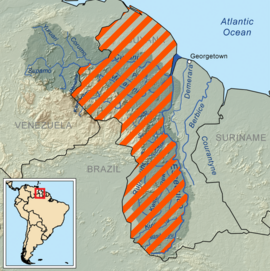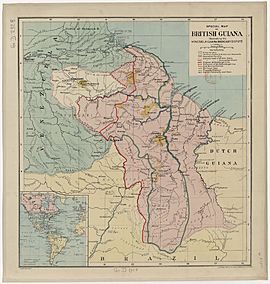Guayana Esequiba facts for kids


Guayana Esequiba, sometimes also called Esequibo, is a disputed territory of 159,500 km2 (61,600 sq mi) west of the Essequibo River that is administered and controlled by Guyana but claimed by Venezuela. The boundary dispute was inherited from the colonial powers (Spain in the case of Venezuela, and the Netherlands and the United Kingdom in the case of Guyana) and has been complicated by the independence of Guyana from the United Kingdom in 1966.
In 1840, the British government commissioned German-born explorer and naturalist Robert Hermann Schomburgk to survey British Guiana's boundaries. This survey resulted in what came to be known as the "Schomburgk Line", which went well beyond the area of British occupation and gave British Guiana control of the mouth of the Orinoco River. These borders were disputed by Venezuela, and tensions worsened after the discovery of gold mines in the region in 1876, culminating with Venezuela severing diplomatic relations with the United Kingdom in 1887. The United Kingdom and Venezuela went into arbitration with mediation from the United States, which resulted in the Paris Arbitral Award in 1899, ruled largely in favour of Britain. In 1949, a memorandum written by Severo Mallet-Prevost, official secretary of the US–Venezuela delegation in the arbitration, and published postumously stated that the Arbitral Award resulted from the pressure by the Tribunal President Friedrich Martens and a political deal between Russia and Britain. Said memorandum led to complaints by Venezuela in the United Nations in 1962, which resulted in the Geneva Agreement, signed with the United Kingdom in 1966.
The status of the territory is subject to the Geneva Agreement, which was signed by the United Kingdom, Venezuela and British Guiana on 17 February 1966. This treaty stipulates that the parties will agree to find a practical, peaceful and satisfactory solution to the dispute. Should there be a stalemate, according to the treaty, the decision as to the means of settlement is to be referred to an "appropriate international organ" or, failing agreement on this point, to the Secretary-General of the United Nations. The Secretary-General referred the entire matter to the International Court of Justice (ICJ). On 18 December 2020, the ICJ accepted the case submitted by Guyana to settle the dispute.
Currently, Venezuela claims all of the land west of the Essequibo river, which it refers to as Zona en Reclamación or Zone in Reclamation. Historically, this did not include the tributaries of the Amazon river and the Pirara area which were only ceded to British Guiana in 1904 during arbitration with Brazil. The Northwestern border of Guayana Esequiba follows the 1905 border as established by the British-Venezuelan Mixed Boundary Commission, in accordance with the Arbitral Award of 3 October 1899. Venezuela currently seeks to abrogate the legal borders and currently agrees only to the Essequibo river boundary.
The territory is divided by Guyana into six administrative regions: Barima-Waini, Cuyuni-Mazaruni, Pomeroon-Supenaam, Potaro-Siparuni, Upper Takutu-Upper Essequibo and Essequibo Islands-West Demerara. Venezuela often depicts it on the map as a striped region.
Demographics
| Region of Guyana | Population (2012) |
|---|---|
| Barima-Waini | 26,941 |
| Cuyuni-Mazaruni | 20,280 |
| Pomeroon-Supenaam | 46,810 |
| Potaro-Siparuni | 10,190 |
| Upper Takutu-Upper Essequibo | 24,212 |
| Essequibo Islands-West Demerara | 107,416 |
| Combined population of claimed regions | 235,849 |
Venezuelan consultative referendum
On 31 October 2023, the government of Guyana filed a request with the ICJ requesting intervention against a proposed referendum approved by the Venezuelan National Electoral Council on 23 October 2023, on annexing Guayana Esequiba as a 24th state of Venezuela, arguing that the referendum served as a pretext for the Venezuelan government to abandon negotiations with Guyana. The proposed referendum was condemned by the Commonwealth of Nations and Caribbean Community (CARICOM), who both issued statements in support of Guyana and the agreed ICJ process for dispute resolution. In response to the increased tensions, the Brazilian military on 29 November 2023 "intensified defensive actions" along its northern border. On 1 December 2023, the ICJ ordered Venezuela to not make any attempts to disrupt the current territory controlled by Guyana until the court makes a later determination. On 3 December, Venezuelans supposedly voted to support the government's position in the dispute, with the National Electoral Council initially reporting 95% of voters approved of each question.
Images for kids
-
A 1625 map by Hessel Gerritsz, showing Dutch territory (in yellow) ranging from the Orinoco River to the Amazon River
-
Punch cartoon after the conclusion of the Tribunal of Arbitration. PEACE AND PLENTY. Lord Salisbury (chuckling). "I like arbitration — In the PROPER PLACE!"
See also
 In Spanish: Guayana Esequiba para niños
In Spanish: Guayana Esequiba para niños
- Belizean–Guatemalan territorial dispute
- Borders of Venezuela
- Essequibo (colony)
- Gran Colombia
- Guayana Region
- Guyana–Venezuela relations
- South American territorial disputes







